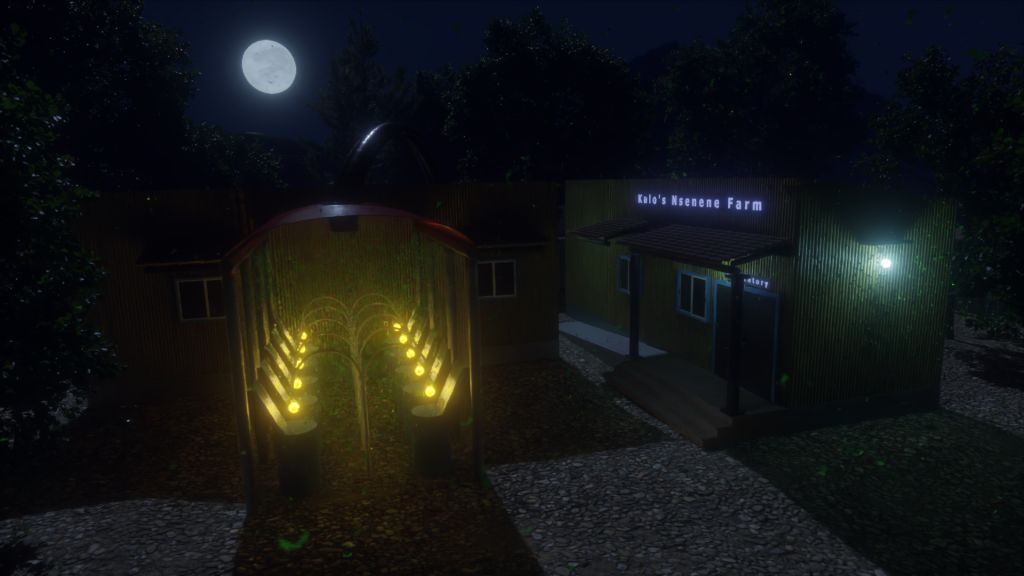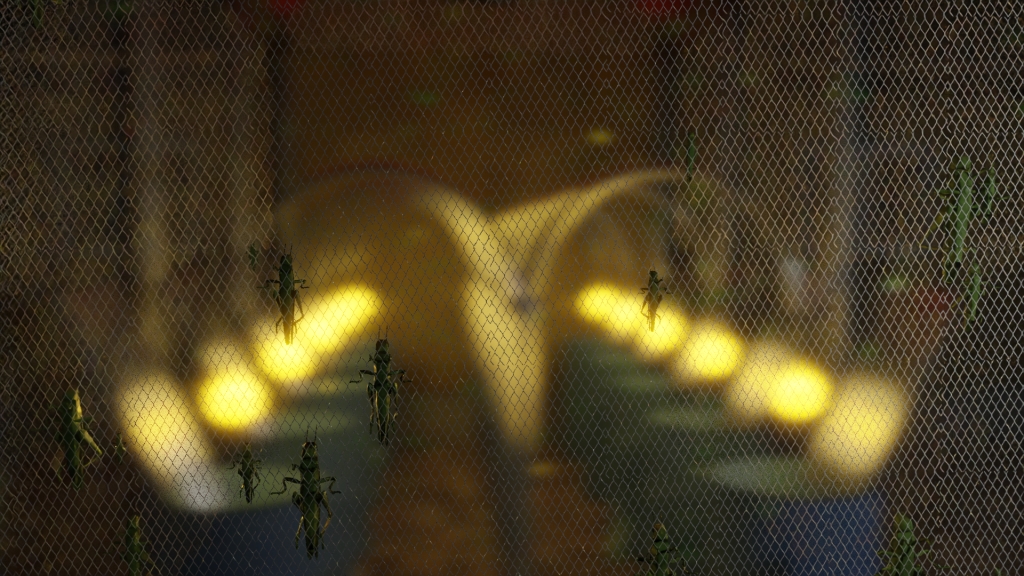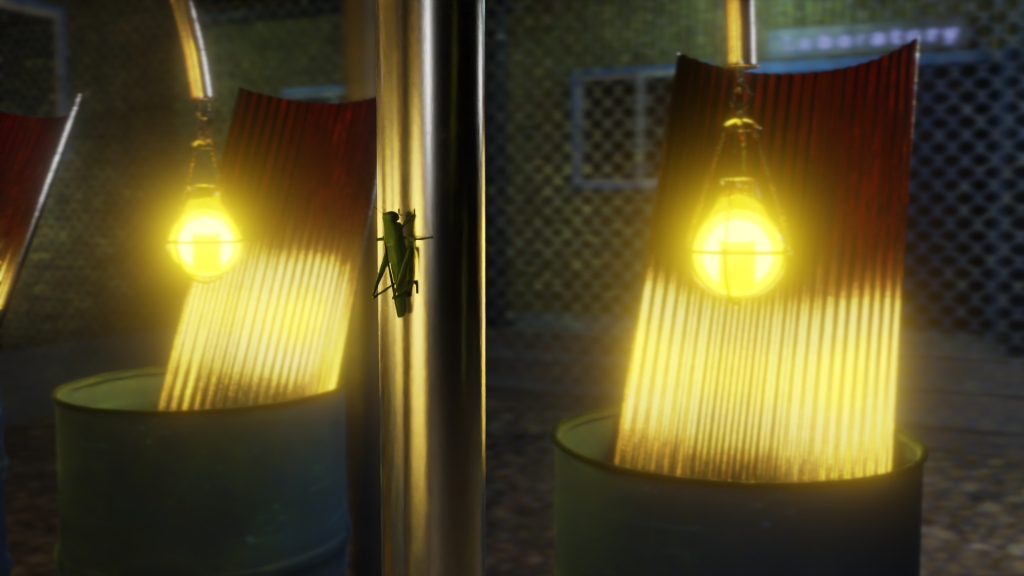By Dilman Dila

It’s my birthday! I turn thirteen today, 6th November 2060. Ha! My brothers and sisters wake me up just after sunrise. They sing to me and give me a cake. I blow out the candles and we laugh and eat the cake even before I brush my teeth. It’s Saturday, so we don’t have to go to school. But we have to work in our mother’s nsenene farm in the morning, preparing the cages, in which insects have been growing for the last several weeks, for harvest. It is always tricky harvesting without letting the grasshoppers escape, and we shall be at it all morning.
“After that,” my sister May says, “we’ll go explore the lights.”
My heart races. The lights are a mystery we encountered last week, as we returned from visiting a relative. They were bright, burning in the darkness like green fire, and smoke rose out of it. We stood at a hill, watching these strange lights, which were on another hill about five miles away. We know nobody lives on that hill. It’s just a bush with ruined houses, so what caused the bright light?
I jumped out of bed in excitement. Within thirty minutes, we’ve brushed our teeth and we race out to the back of our house, where nsenene cages sprawl into the distance. Each is about the size of a house, roofed with solar-stone-slats, and covered with nets to prevent the insects from escaping. To harvest, we have to open special holes in the nets, and then cover these holes with sacks. Then the insects fly through this hole into the sack. Once the sack is full we put it on a lorry to transport it to Kampala for sale. Each month we send almost ten lorries full of nsenene sacks. Of course my mother has workers who do the job full time, but she assigns us a cage to manage, for she wants us to learn the job.

After we’ve eaten lunch, which is a special birthday meal for me (more cake!) we get our bikes and set off to explore the green lights. We ride for about ten minutes from our farm, past short and yellowish grass because the drought has been long and hard. Kampala and the surrounding areas suffer from floods, and parts of the city have turned into lakes, but out here we have not seen rain in a long time, and the ground is dry and parched with thirst. The grass looks burned and withered. Some trees are bare of leaves, their branches white and bleached like dry bones.
We reach the hill where we saw the lights, but we can’t see anything. It’s about three PM, and my sister thinks it should be okay to ride over there and take a look, and then get back before it’s dark. She is our gang leader, and has a way to soothe Mum if Mum gets angry with us. There’s no road to this hill, and so we have to leave our bicycles at a friend’s house and walk through the bushes, suffering the scratches from the brittle shrubs. We aren’t walking fast, and we play along the way, forgetting to worry about the time, so by the time we arrive, darkness is already creeping upon us.
“We can’t stay out late!” I say. I’m the youngest and clearly the most scared. The others laugh.
“Look!” my sister says. “There it is!”
In the gathering darkness, about half a mile up the hill, we see the lights, green and awesome, with smoke swirling about them like ghosts. For a moment, even my fear of staying out late disappears. There is a sense of danger, seeing the lights through the thin vegetation, green in the blue of dusk. We half-run the rest of the way, our feet throwing up dust from the hard ground.
As we approach, we notice the ruins of a homestead, the kind they used to build long ago before the big rains devastated the world. Before I was born. The concrete walls have crumbled, with weeds growing out of the brickwork, and iron-sheet roofs that have caved in as if under the weight of the dust and dirt that has gathered on them through the ages. The lights blaze behind one of these ruined houses, and we fearfully creep around and peek.
Huge bulbs are fixed on three poles, in the middle of a rectangle made with drums. An iron-sheet sticks out of each of the drums, creating a surreal figure. For a moment we stare at the spectacle. What is the purpose of this? The drums too have been sitting out there for a long, long time. So long that they have become part of the ground, with weeds growing out of them.
“What is this?” I say.
Then we notice insects flying about. It doesn’t take me a moment to recognize nsenene. There are not many, just a few of them, fluttering about in the lights, and then falling onto the iron-sheets and sliding into the drums. One comes close enough for me to catch it, and I notice it is very different from the ones we grow in our farm. These ones don’t have the red dot on their foreheads….

“An original nsenene harvest farm,” a voice says.
We all jump in fright, and turn to see an old man, a little dirty and in near rags, stepping out of a ruin. He seems to be smiling, though it might just be his wrinkles playing tricks on me. We take steps backward in fear, but he holds out his hand to show us he means no harm.
“I know you,” he says, squinting at us. “You are from Maria’s nsenene farm?”
We exchange glances, and then greetings, wondering how to explain our presence. He doesn’t press us. He has a faraway look, as he stares at the drums, and then he shakes his head sadly.
“The insects need rain to breed,” he says. “When I was a child, we would know the year is coming to an end when we saw grasshoppers. At that time we didn’t know they could be farmed like cattle or chicken. We just waited for them to come and we feasted on them without knowing how exactly they came about. Then someone figured out the kind of grass they lay their eggs in, what they ate, and such things, and then people like your mother built special farms with special feeds.”

He shrugs, and turns back to us and I wonder if those are tears in his eyes. “They need rain to breed, but we haven’t seen rain here in a long time. I keep this harvest set up ready, just in case by some miracle they come back.”
Now that the lights are explained, the excitement dies down. We had expected something spectacular, but this old farm could not really engage our interest for long.
“We don’t have real nsenene anymore,” the old man says. “The thing you people grow, it can’t beat the taste of natural nsenene. Do you want a taste?”
“Perhaps another day,” my sister says quickly. “It’s late. Goodbye.”
We start our trek back, and I’m a little disappointed. I wish the lights had turned out to be something more interesting than a ruin. My birthday would have been real special then.


Dilman Dila is a Ugandan writer, filmmaker, and social activist. He is the author of a collection of short stories, A Killing in the Sun. He is currently working on his debut sci-fi novel, Dreams of a Yellow Balloon. He has been listed in several prestigious prizes, including the BBC International Radio Playwriting Competition (2014), the Commonwealth Short Story Prize (2013), and the Short Story Day Africa prize (2013, 2014). His short fiction have featured in several magazines and anthologies.

Let’s Follow up
- What is happening in the story?
- Who is being affected by the story?
- Can you identify the aim of the main character?
- What outcome or change has been depicted in the story?
- Can you separate fact from fiction in the story?
- Pick a minor character mentioned in the story and imagine what they were doing on the same day.
- Describe the future as depicted in the story. Imagine that you work for a local newspaper in the future depicted by the story. What recent stories have you covered? Write a couple of headlines.
- Describe the new terms, ideas and situations that you have picked from the story.
- What are the real world inspirations and scenarios that the writer used to tell the story?
- Describe the steps by which such a future could come about, starting from now.
